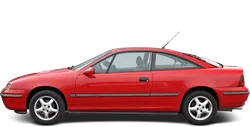

Opel Calibra Generation 1 Facelift 1994 Overview
Discover the Opel Calibra, especially the 1994 Generation 1 Facelift. This model stands out with its sleek design and impressive performance, particularly in Portugal.
The Opel Calibra Generation 1, specifically the facelift model released in 1994, is a classic car that holds a special place in the hearts of car enthusiasts. Known for its sleek design...
Technical Specifications
Select Version
Dimensions
Engine
Driving
Others
History and Features
Mycarro AI
Feb 1, 2024
Introduction
The Opel Calibra Generation 1, specifically the facelift model released in 1994, is a classic car that holds a special place in the hearts of car enthusiasts. Known for its sleek design and impressive performance, the Calibra Generation 1 represented a bold leap forward for Opel. In this article, we will delve into the key features and highlights of this iconic car.
Design and Body
The Calibra Generation 1 received a significant facelift in 1994, transforming it into a true head-turner. The design featured a more aggressive front grille, improved aerodynamics, and a sleeker profile. Its distinctive "blade" design, characterized by a sharp crease running from the front wheel arch to the rear, gave the car a dynamic and athletic appearance.
Performance and Engine Options
When it comes to performance, the Calibra Generation 1 did not disappoint. It offered a range of engine options to suit different driving preferences. The most notable engine was the 2.0-liter 16-valve engine, delivering an impressive 150 horsepower. This enabled the Calibra to accelerate from 0 to 60 mph in just under 8 seconds, making it one of the fastest cars of its time.
Interior and Features
Inside the Calibra Generation 1, drivers were treated to a comfortable and stylish cabin. The ergonomically designed seats provided excellent support, making long journeys a breeze. The facelift model also boasted new features such as improved sound insulation, power windows, and a reliable air conditioning system. These enhancements added to the overall driving experience and ensured a pleasant journey for the occupants.
Safety and Technology
Opel placed a strong emphasis on safety in the Calibra Generation 1. The car was equipped with advanced safety features for its time, including ABS, traction control, and airbags for both the driver and front passenger. These safety measures provided peace of mind to drivers and their passengers, making the Calibra a reliable choice in terms of safety.
Legacy and Impact
The Calibra Generation 1 enjoyed a successful run and made a lasting impact on the automotive industry. It was praised for its cutting-edge design, impressive performance, and advanced features. The Calibra's success in motorsports, particularly in the German Touring Car Championship (DTM), further solidified its reputation as a high-performance sports car.
Conclusion
The Opel Calibra Generation 1 (Facelift 1994) was a true gem of its time. With its striking design, powerful engine options, comfortable interior, and advanced safety features, it captivated the hearts of car enthusiasts worldwide. Whether on the road or on the racetrack, the Calibra Generation 1 proved itself as a worthy competitor. Even today, it remains a symbol of Opel's commitment to innovation and performance.
